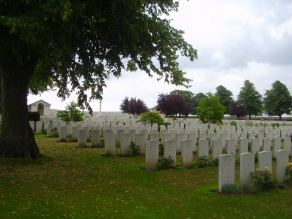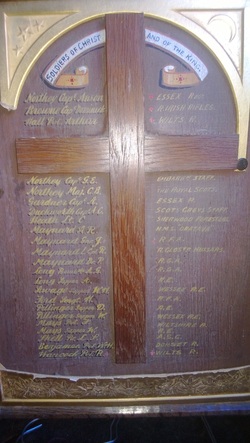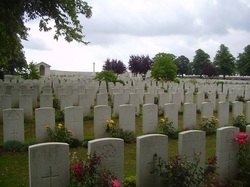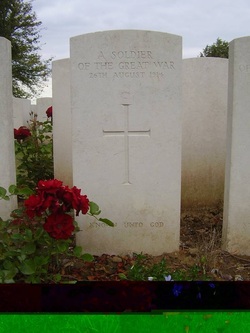 Arthur Hall's grave at Serre Road No 3
Arthur Hall's grave at Serre Road No 3
Finding Private Hall
The Search for a Box Soldier of the Great War
Carole French tells her moving story of finding the grave of one of Box's fallen soldiers.
She tells you how to find the grave and invites you to lay a cross on their memorials if you visit the battle sites in the next four years. Please send us your pictures so the whole village can remember its fallen.
The Search for a Box Soldier of the Great War
Carole French tells her moving story of finding the grave of one of Box's fallen soldiers.
She tells you how to find the grave and invites you to lay a cross on their memorials if you visit the battle sites in the next four years. Please send us your pictures so the whole village can remember its fallen.
I don’t think anything can
prepare you for your first visit to a war cemetery. I first visited sites in
Belgium and I well remember my feelings entering through the iron gates. The Commonwealth
War Graves Commission (CWGC) maintains the cemeteries beautifully; the planting
is lovely and the grass immaculate. Teams of gardeners visit each site very
early in the morning (they are rarely seen).
The gardeners’ hut is tucked away in the back corner of each cemetery.
All cemeteries have a small cupboard set into the wall near the entrance with a
list of the dead and a visitor’s book. There is always a white stone set into
the wall signifying that the land of the cemetery is a permanent gift from the
people of France in gratitude for the sacrifice made.
 The memorial in Ditteridge Church
The memorial in Ditteridge Church
I had developed an interest
in the war graves from a memorial plaque on the wall behind the lectern in St
Christopher’s Church, Ditteridge, which lists the five soldiers from Ditteridge
parish who died in the Great War conflict. Their names were very familiar to me
with their initials and the date of their death, but no Christian names or
other details are given.
I had studied the war poets at school and was aware of the CWGC. I looked up more details on the Ancestry.com website and soon discovered a lot about these names but investigating a soldier is a very addictive occupation (be warned!) and I wanted to understand more. Only three of the five had known graves and one of these was in Box cemetery. So I chose to find out more about one young soldier, Private Arthur Hall, who had been buried in Northern France. Having found a reason to visit the area (and a willing daughter to accompany me) I booked a chambre d’hote just west of Amiens for three nights and a cheap ferry crossing.
The poignancy of the cemeteries, for me, lies in the individual graves. The familiarity of the names (I found a grave with one of my sons' names, and his age in High Wood Cemetery), and the sheer quantity of them is deeply shocking. Cemeteries in England are overwhelmingly the resting place of the elderly; the War Graves are the resting place of the young. Once or twice you may find someone in their 40s or 50s, there are many in their 30s, but the vast majority are in their 20s. Although men under the age of 19 were not supposed to serve abroad, there are a considerable number of 18 and 19 year old boys.
Each un-named grave is inscribed A soldier of the Great War, Known Unto God - a phrase chosen by Kipling which replaces the French inconnu (simply unknown). But the inscription which is especially poignant is that next to the earth, at the lower edge of each naming stone. It is the words chosen by their families. At a small cost, each bereaved family was invited to choose a short phrase or sentence to personalise the gravestone.
Reflecting the society in which they lived, these phrases are often biblical, Thy Will be done; or they praise the bravery and patriotism of the soldier, Duty done. Sometimes they are simply heartrending, Gone to be with his brothers; or He was my beloved. Interestingly, the graves of Canadian and Australian soldiers have less formal words. I came across a grave in Pozieres which simply says What a Waste, unusual for that era.
I had studied the war poets at school and was aware of the CWGC. I looked up more details on the Ancestry.com website and soon discovered a lot about these names but investigating a soldier is a very addictive occupation (be warned!) and I wanted to understand more. Only three of the five had known graves and one of these was in Box cemetery. So I chose to find out more about one young soldier, Private Arthur Hall, who had been buried in Northern France. Having found a reason to visit the area (and a willing daughter to accompany me) I booked a chambre d’hote just west of Amiens for three nights and a cheap ferry crossing.
The poignancy of the cemeteries, for me, lies in the individual graves. The familiarity of the names (I found a grave with one of my sons' names, and his age in High Wood Cemetery), and the sheer quantity of them is deeply shocking. Cemeteries in England are overwhelmingly the resting place of the elderly; the War Graves are the resting place of the young. Once or twice you may find someone in their 40s or 50s, there are many in their 30s, but the vast majority are in their 20s. Although men under the age of 19 were not supposed to serve abroad, there are a considerable number of 18 and 19 year old boys.
Each un-named grave is inscribed A soldier of the Great War, Known Unto God - a phrase chosen by Kipling which replaces the French inconnu (simply unknown). But the inscription which is especially poignant is that next to the earth, at the lower edge of each naming stone. It is the words chosen by their families. At a small cost, each bereaved family was invited to choose a short phrase or sentence to personalise the gravestone.
Reflecting the society in which they lived, these phrases are often biblical, Thy Will be done; or they praise the bravery and patriotism of the soldier, Duty done. Sometimes they are simply heartrending, Gone to be with his brothers; or He was my beloved. Interestingly, the graves of Canadian and Australian soldiers have less formal words. I came across a grave in Pozieres which simply says What a Waste, unusual for that era.
 Serre Road No 3 cemetery
Serre Road No 3 cemetery
The Somme area has hundreds of battlefield cemeteries, varying in size from about 20 recorded names to thousands. The memorial at Thiepval , designed by Lutyens, is a massive arch with 73,000 names inscribed on its piers simply listing those who were never identified, The Missing of The Somme.
It is said that the majority of British men can find their own initial and surname inscribed on the monument. The visitors’ book has comments Come to remember Great Uncle Bob died 1st July 1916 and several are accompanied by the copy of a sepia photograph of a young man in uniform.
The farmland around the monument is calm and gently beautiful, the shell holes and trenches having been ploughed out over the last century. Apart from the memorials and cemeteries, however, there are two other clues to the past in the landscape. Ploughed fields have particles of brick in the earth, the remnants of houses and settlements blown into obscurity in the battles that raged over the land. And, where the woods have been allowed to re-grow, the shell holes still survive, pitting the land where saplings have grown to maturity in the last hundred years. These woods are all graves of the dead buried only by nature. The woods at Mametz are decorated with poppy wreaths to commemorate the sacrifice of the Welsh battalion in that place.
Private Arthur Hall, of the Wiltshire Regiment, was aged 20 when he died on the Somme in October 1916. We knew that he was buried in Serre Road cemetery in the Northern part of the battlefield. Passing what appeared to be fields of headstones we pulled in at Serre Road number 3. There are 7,127 graves; 4944 of which are unidentified . These are the massed multitude of silent witnesses to the desolation of war. The directory was found and the whereabouts of Arthur ascertained.
It is said that the majority of British men can find their own initial and surname inscribed on the monument. The visitors’ book has comments Come to remember Great Uncle Bob died 1st July 1916 and several are accompanied by the copy of a sepia photograph of a young man in uniform.
The farmland around the monument is calm and gently beautiful, the shell holes and trenches having been ploughed out over the last century. Apart from the memorials and cemeteries, however, there are two other clues to the past in the landscape. Ploughed fields have particles of brick in the earth, the remnants of houses and settlements blown into obscurity in the battles that raged over the land. And, where the woods have been allowed to re-grow, the shell holes still survive, pitting the land where saplings have grown to maturity in the last hundred years. These woods are all graves of the dead buried only by nature. The woods at Mametz are decorated with poppy wreaths to commemorate the sacrifice of the Welsh battalion in that place.
Private Arthur Hall, of the Wiltshire Regiment, was aged 20 when he died on the Somme in October 1916. We knew that he was buried in Serre Road cemetery in the Northern part of the battlefield. Passing what appeared to be fields of headstones we pulled in at Serre Road number 3. There are 7,127 graves; 4944 of which are unidentified . These are the massed multitude of silent witnesses to the desolation of war. The directory was found and the whereabouts of Arthur ascertained.
 Known Unto God
Known Unto God
He lies not far from the road, to the left of the field. His grave has the words Peace, Perfect Peace engraved at the lower edge and a rose was in flower next to the stone. I thought of Drewett’s Mill, where he had lived, and of Quarry Woods, where I now walk my dog, and where his father worked.
I thought of our village and church, places he would have known. We left a small remembrance cross in the earth next to the grave Arthur Hall, remembered at Ditteridge and Box, Wiltshire. One grave amongst thousands, we walked up and down the rows for a while.
In order to engage with the sacrifice made by that generation in this centenary year we need to focus on the individual soldier lost in the vast army of the dead. Someone with your name, or your father’s or brother’s. Someone who lived in your house, or who is remembered on a memorial that you walk past. We say on a Sunday every November that we will remember them. These men and their suffering is out of living memory now but we can still honour their sacrifice.
I thought of our village and church, places he would have known. We left a small remembrance cross in the earth next to the grave Arthur Hall, remembered at Ditteridge and Box, Wiltshire. One grave amongst thousands, we walked up and down the rows for a while.
In order to engage with the sacrifice made by that generation in this centenary year we need to focus on the individual soldier lost in the vast army of the dead. Someone with your name, or your father’s or brother’s. Someone who lived in your house, or who is remembered on a memorial that you walk past. We say on a Sunday every November that we will remember them. These men and their suffering is out of living memory now but we can still honour their sacrifice.